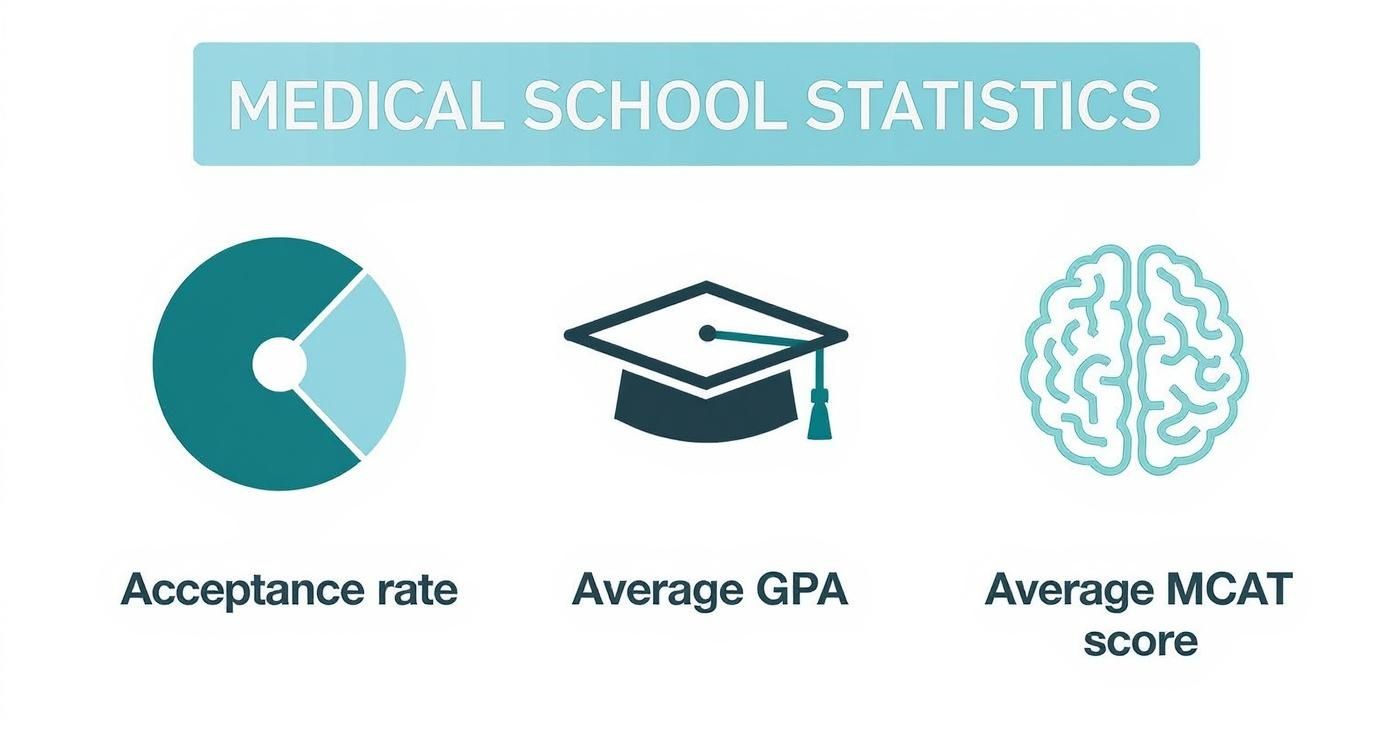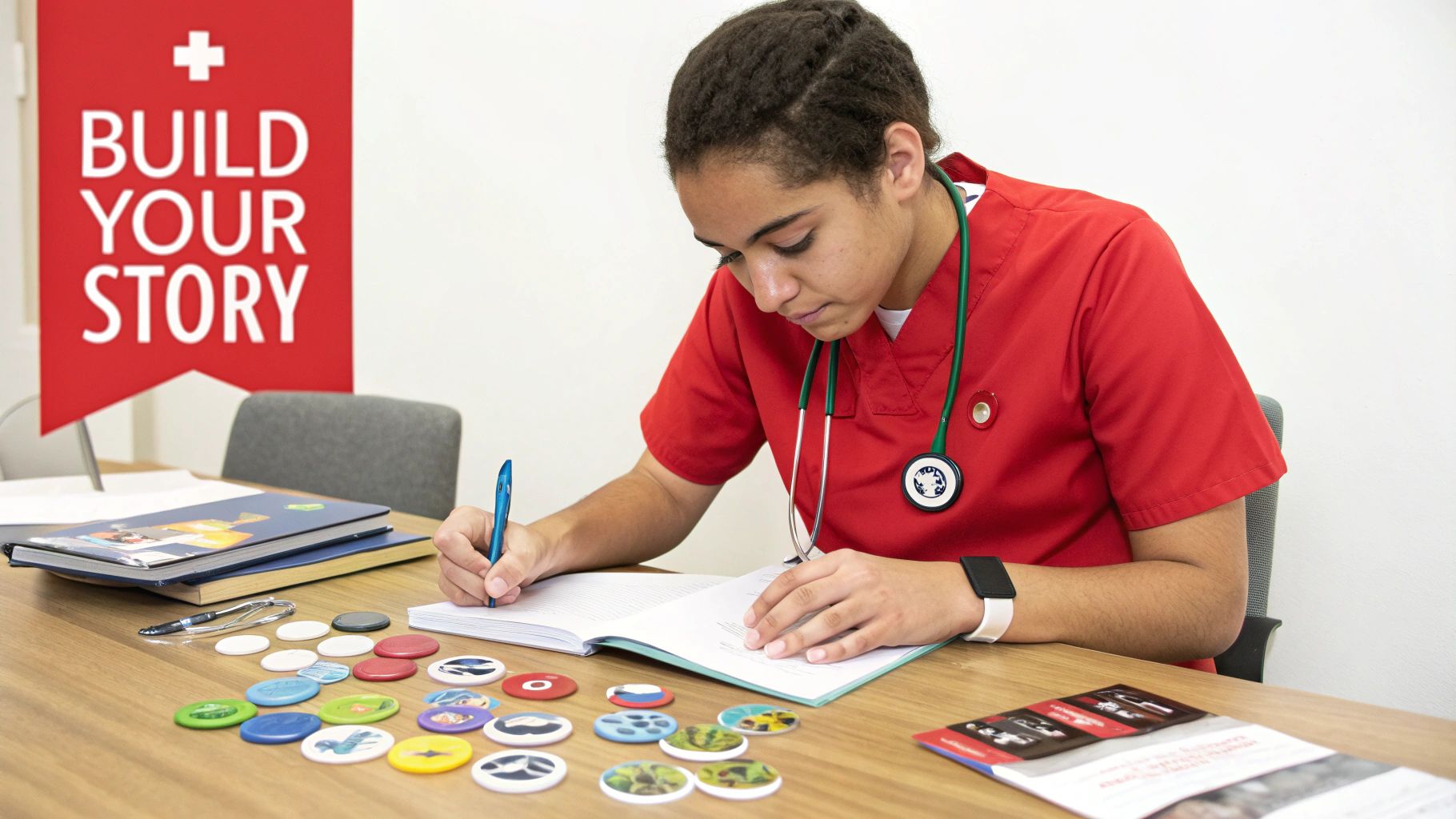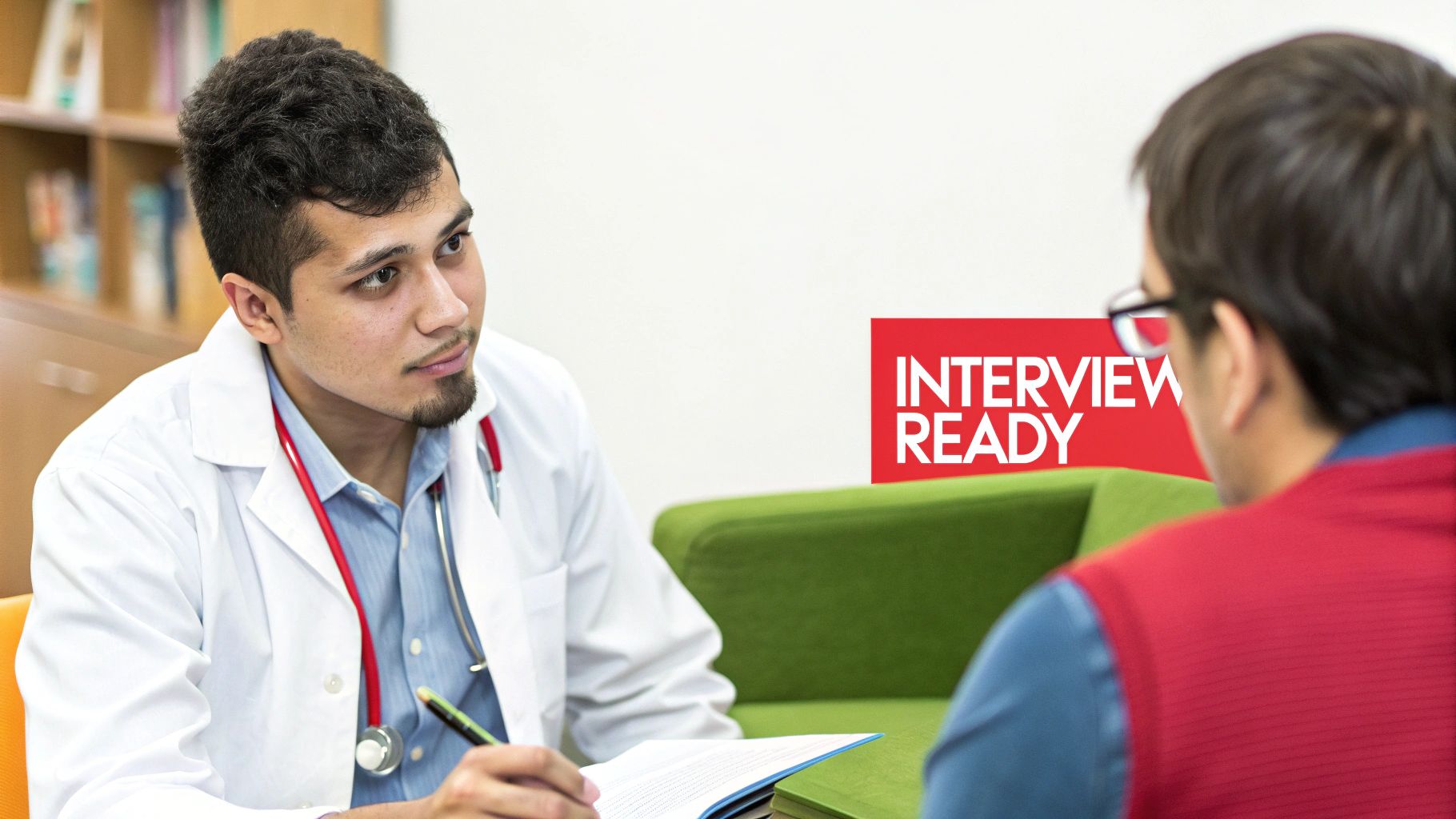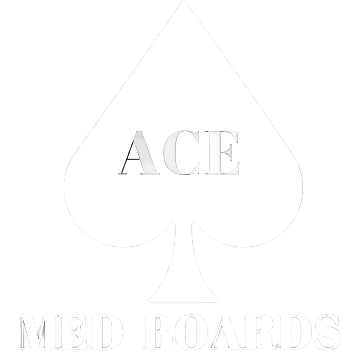Applying to medical school is a marathon, not a sprint. It’s a multi-year journey that demands careful planning, academic grit, and a whole lot of personal growth. The goal isn't just to rack up high scores; it's to build a compelling story that shows you have the resilience, empathy, and dedication to become a great physician. Getting this right from the start is half the battle.
What It Really Takes to Get In Today
The med school admissions game has changed. While a killer GPA and MCAT score are still your ticket to the dance, they won't get you on the floor by themselves. Admissions committees now use a holistic review process, which is just a fancy way of saying they look at everything to get a full picture of who you are.
This means they’re digging deeper, searching for specific qualities that don’t show up on a transcript. The AAMC calls these the Core Competencies, and they're non-negotiable for any aspiring doctor.
- Resilience and Adaptability: Have you been knocked down and gotten back up? They want to see that you can handle pressure and learn from failure.
- Empathy and Compassion: Can you prove you genuinely care about people? Your experiences need to reflect a real concern for others.
- Teamwork and Collaboration: Medicine is a team sport. You need to show you can play well with others.
- Cultural Competence: Have you worked with people from different walks of life? This is critical in today's diverse healthcare landscape.
The Numbers Game Still Matters
Let's be real—while your personal story is key, the numbers have to be there. The competition is intense, and knowing the benchmarks is the first step to building a competitive application.
The reality is that getting into medical school in the U.S. is tougher than ever. Back in 2016–2017, only 39.6% of applicants matriculated. That number improved slightly to 43% by 2025–2026, with 23,440 students enrolling. During that same time, the average GPA for matriculants climbed from 3.77 to 3.81, and the average MCAT score edged up from 511.7 to 512.1.
The infographic below breaks down the averages for accepted students, giving you a clear look at the acceptance rates, GPAs, and MCAT scores you're up against.

This data makes it crystal clear: successful applicants are typically academic high-fliers. A strong quantitative profile isn't just a suggestion; it's a prerequisite.
To help you visualize what a competitive profile looks like, here's a quick summary of the key metrics admissions committees are looking for.
Key Applicant Metrics At a Glance
| Application Component | What Committees Look For | Target Benchmark (Competitive Applicant) |
|---|---|---|
| Overall GPA | Consistent high performance, upward trend | 3.7+ |
| Science GPA (BCPM) | Strong foundation in core sciences | 3.65+ |
| MCAT Score | Balanced performance across all sections | 512+ |
| Clinical Experience | Meaningful patient interaction, understanding of medicine | 150+ hours |
| Research Experience | Understanding of the scientific method, contribution | Varies by school, but 1-2 significant experiences are ideal |
| Volunteering | Commitment to service, community engagement | 100+ hours (non-clinical) |
| Leadership/Teamwork | Demonstrated ability to lead and collaborate | 1-2 long-term roles |
This table serves as a general guide. Remember that every school weighs these components differently, but hitting these benchmarks puts you in a strong position.
Beyond the Stats: A Cohesive Narrative
Your job is to connect all these dots—your grades, experiences, and personal qualities—into a story that makes sense. A 4.0 GPA with a random assortment of activities is far less compelling than a slightly lower GPA backed by a clear, passionate narrative.
The strongest applicants connect their experiences—clinical, research, volunteer, personal—into a powerful story that clearly and authentically answers the fundamental question: "Why do you want to be a doctor?"
Every part of your application, from your activities list to your essays and letters of recommendation, should add another layer to this story. You need to show, not just tell, the admissions committee that you have the brains, character, and drive to succeed in medicine. For a deeper look at these essential qualities, check out our guide on what medical schools look for in applicants. This blend of academic excellence and a compelling personal story is what truly makes an application stand out today.
Building Your Story Years Before You Apply
Let’s be honest: applying to medical school is a marathon, not a sprint. The applications that truly stand out aren’t slapped together in a few frantic months. They're the product of years of thoughtful choices, genuine engagement, and real-world experience. This is where you stop just checking boxes and start building a narrative that actually shows—not just tells—why you’re committed to medicine.
This whole process really kicks off when you shift your mindset. Stop asking, "What will look good on my application?" and start asking, "What am I genuinely curious about?" or "What kind of service actually means something to me?" That simple change is the secret to finding roles you can stick with and that will truly shape you.
Think about it. If you’re passionate about working with underserved kids, volunteering at a free pediatric clinic will be incredibly impactful—both for you and your application. It’s a world away from a generic hospital volunteer gig that doesn't light a fire in you.

Beyond the Pre-Med Checklist
Every pre-med knows the standard playbook: get clinical experience, do some research, volunteer, and shadow a doctor. The challenge is to take these common categories and infuse them with your own personality and passions. This is how you turn a simple list of activities into a story that an admissions committee will remember.
A huge part of this is digging deep into your own motivations. When you truly find purpose in life and understand why you're pursuing medicine, your application and interview answers gain a powerful sense of clarity. When you’re driven by a clear purpose, all your experiences start to connect and build on each other naturally.
Your application should tell a story that only you can tell. It’s the combination of your unique experiences, reflections, and motivations that will make an admissions committee remember you.
Curating Meaningful Experiences
Let's get practical about how to approach each key area with real intention. It’s not about logging the most hours; it's about the quality and impact of what you do.
Clinical Experience
This one is absolutely non-negotiable. You have to prove you understand what it’s like to be around patients in a healthcare setting. But how you get that experience matters immensely.
- Active vs. Passive Roles: Being a scribe or a medical assistant, where you're right there in the mix of patient care, is infinitely more valuable than a role where you’re just stocking shelves. You want to be in the room where it happens, observing and contributing alongside physicians.
- Longitudinal Commitment: Sticking with one or two clinical roles for a year or more demonstrates real dedication. It gives you the chance to build relationships, earn trust, and take on more responsibility over time. That’s far more impressive than jumping between several short-term positions.
Research Opportunities
Research is your chance to show your intellectual curiosity and that you understand the scientific process that underpins medicine. You don't need a first-author publication in a major journal, but you do need to show you were genuinely involved.
Find a lab where you can do more than just wash glassware. The best research experiences are those where you get to contribute to a real project, understand the questions being asked, and maybe even get to present your work at a student symposium.
Shadowing Strategically
Shadowing offers a crucial window into the daily life of a physician. To make it truly count, you have to be more than just a fly on the wall.
- Diversify Your Exposure: Try to shadow physicians in different specialties and environments. Spending time with a primary care doctor in a rural clinic and then with a surgeon in a huge academic hospital will give you a much richer, more realistic view of the medical field.
- Engage and Reflect: Show up prepared with thoughtful questions. After every shadowing session, take 15 minutes to journal. Write down what you saw, what you learned, and how it either solidified or challenged your desire to become a doctor. Trust me, these reflections are pure gold when it’s time to write your essays.
Building Your Support Network
The relationships you build during your undergrad years are just as critical as the hours you log. These are the people who will become your mentors and, eventually, the ones who write your letters of recommendation.
Start identifying professors, physicians, and research PIs who know you well. Cultivate those relationships by going to office hours, asking for advice, and being someone they can count on. When it's time to ask for a letter, you want them to write a personal, detailed account of your strengths, not just pull from a generic template.
As you collect all these experiences, keep meticulous records. A detailed log of your activities, hours, responsibilities, and key reflections is vital. This will be your go-to resource for your primary application. Our guide on creating a comprehensive medical school CV offers a great framework for organizing this information long before you even think about applying. Building your story is a deliberate act of choosing, engaging, and reflecting over several years.
Mastering the MCAT and Your Primary Application
Alright, let's talk about the two behemoths of the application cycle: the MCAT and your primary application. Think of them as the one-two punch of your candidacy. The MCAT is the raw, quantitative proof of your academic horsepower, while the primary app is where you tell your story and show them who you are beyond the numbers.
Trying to juggle both at once feels like a marathon, and honestly, it is. But the secret isn't to treat them as separate, terrifying tasks. The most successful applicants weave them together into one cohesive, powerful narrative.

Conquering the MCAT with a Smart Strategy
Let's be clear: the MCAT is not just another science test. It's an eight-hour beast designed to test your critical thinking, problem-solving, and endurance just as much as your knowledge of glycolysis. Winning this fight comes down to having a smart, structured study plan that actually fits you.
First, you need to be honest with yourself. Are you a lone wolf who can grind through textbooks and practice questions with sheer discipline? Or do you need the structure and accountability of a formal prep course? A self-study plan is flexible and cheaper, but it demands an iron will. A prep course, on the other hand, gives you a clear roadmap and expert support, which can be a lifesaver.
Either way, you’re likely looking at a 3-6 month commitment. This timeline typically breaks down into two distinct phases:
- Content Review: For the first 6-12 weeks, you'll be diving back into the foundational concepts—biology, chemistry, physics, biochemistry, psychology, and sociology. This isn't just about memorizing facts; it's about truly understanding them again.
- Practice and Application: The rest of your time should be dedicated to taking full-length practice exams under timed conditions. This is where the magic happens. You build stamina, pinpoint your weak spots, and get a real feel for the test's rhythm and tricky question styles.
For a deeper dive, our guide on how to study for the MCAT lays out detailed schedules and top-tier resources to help you build a bulletproof plan.
Crafting a Compelling Personal Statement
Your MCAT score gets your foot in the door, but your personal statement is what invites you to sit down. This 5,300-character essay is your single best chance to show the admissions committee the person behind the stats. It’s where you connect the dots of your journey and articulate your "why."
The biggest mistake I see students make is just turning their resume into paragraph form. Don't do that. Your goal is to tell a story that answers the most important question: "Why do you want to be a doctor?" Use compelling anecdotes that showcase your character, your resilience, and your empathy.
A memorable personal statement doesn't just list what you did; it reflects on why you did it and what you learned. It transforms your experiences from a checklist of activities into a powerful story of personal growth and commitment.
Start by brainstorming those pivotal moments. Think about a specific patient interaction that changed everything for you, or a research problem that kept you up at night. Pick two or three of these powerful stories and weave them into a narrative that feels genuine because it is genuine.
Describing Your Activities with Impact
The AMCAS Work and Activities section gives you space for up to 15 experiences. This isn't just tedious data entry; it's another chance to tell your story. You get 700 characters to describe what you did and, for your three "most meaningful" experiences, another 1,325 characters to explain why they mattered.
Use this space wisely. Ditch the passive descriptions and adopt active, results-oriented language.
- Weak Description: "Volunteered at a hospital."
- Strong Description: "Assisted nursing staff with patient transport and comfort measures, directly engaging with over 50 patients in the geriatric ward to provide companionship and reduce feelings of isolation. This experience taught me the profound impact of empathy in clinical care."
See the difference? The strong description shifts the focus from what you did to what you accomplished and learned. It gives them concrete proof of your skills and reinforces the themes from your personal statement.
The data doesn't lie: successful applicants kill it on both the quantitative and qualitative fronts. In the 2022–2023 cycle, the average MCAT for students who got in was 511.9, and top programs often look for scores north of 517. With 155 accredited allopathic (MD) schools and 38 osteopathic (DO) schools in the U.S., the competition is intense. Every single piece of your primary application has to be polished to perfection.
Navigating Secondaries and Securing Strong Letters
Just when you think you can catch your breath after hitting "submit" on your primary application, the secondaries start rolling in. This isn't a gentle trickle; it's a flood. This is where the real medical school application marathon kicks off, and managing dozens of unique essays while securing powerful letters of recommendation is a balancing act that will test your strategy and stamina.
The single most important key to surviving secondaries is organization and pre-writing. Most schools send them to nearly every applicant, often just days after your primary is verified. The unspoken rule is a quick turnaround, ideally within two weeks. To hit that deadline without your essay quality plummeting, you have to start writing before you even get the prompts.
Good news: many schools reuse their secondary prompts year after year. A quick online search will almost certainly turn up the most recent essay questions for every school on your list. This lets you draft thoughtful, specific answers well in advance, which is the best defense against the burnout that sinks so many otherwise qualified applicants.
Decoding Common Secondary Prompts
Secondary essays are all about fit. They’re designed to see if you understand a school's specific mission and culture. Admissions committees can spot generic, copy-pasted answers from a mile away, and that's the fastest way to land your application in the "no" pile. Each response has to be tailored with precision.
Let’s break down two of the prompts you are virtually guaranteed to see:
- The "Why Our School?" Question: This is your moment to prove you've done your homework. Go deeper than the homepage. Dig into their curriculum details, specific research labs, or unique clinical opportunities. Mention a professor whose work genuinely excites you or a student-run clinic that aligns perfectly with your goals.
- The "How Will You Contribute to Our Diversity?" Question: Diversity is much bigger than just race or ethnicity. It includes your unique life experiences, skills, perspectives, and background. Maybe you’re a first-generation college student, a former musician, a non-traditional applicant with a previous career, or grew up in a rural town. Connect your unique story to how you will enrich the learning environment for your future classmates.
Your secondary essays need to paint a vivid picture of you on that specific campus. You're not just showing the admissions committee that you're a qualified candidate; you're showing them you're the right candidate for their program.
Securing Impactful Letters of Recommendation
While you’re buried in essays, you also have to manage the crucial process of getting strong letters of recommendation. These letters are the third-person validation of your character, work ethic, and potential as a future physician. The quality of these letters can absolutely make or break your application.
Here's a pro tip: the best letter writer isn't the most famous professor or the department head. The ideal writer is someone who knows you well and can write about your abilities using specific, personal anecdotes. A glowing, detailed letter from a junior professor who supervised your research for a year is infinitely more valuable than a generic form letter from a Nobel laureate who barely remembers your name.
Your choice of letter writers might also be influenced by whether you're applying to Allopathic (MD) or Osteopathic (DO) programs. Here’s a quick look at some key differences.
MD vs DO School Application Considerations
When deciding who to ask for letters and how to frame your application, understanding the subtle differences between MD and DO schools is key. While both paths lead to becoming a fully licensed physician, their application systems and philosophical approaches have distinct features.
The table below breaks down some of the most important considerations for applicants.
| Feature | Allopathic (MD) Schools | Osteopathic (DO) Schools |
|---|---|---|
| Primary Service | AMCAS | AACOMAS |
| Letter Focus | Heavy emphasis on science faculty and research mentors. | Often requires a letter from a DO physician to show you understand the field. |
| Philosophy | Focus on evidence-based, allopathic medicine. | Emphasis on a holistic, whole-person approach to care. |
Thinking about these differences early on will help you build a more targeted and effective application strategy, ensuring you meet the unique expectations of each type of program.
Aim to ask your letter writers at least 4-6 weeks before your application is due. This isn't just a professional courtesy; it gives them the time they need to write a truly thoughtful letter without feeling rushed.
When you make the request, don't just ask. Provide them with a comprehensive packet that makes their job as easy as possible.
Your portfolio for them should include:
- Your updated CV or resume.
- A draft of your personal statement.
- A short summary of your most meaningful experiences.
- The AAMC Letter Request Form with your AAMC ID.
- A clear, friendly reminder of the deadline.
Giving them this information ensures your writer has all the context needed to craft a powerful, personalized letter that highlights your greatest strengths and reinforces the narrative you've built throughout the rest of your application.
Winning the Medical School Interview
Landing an interview invitation is a huge deal. Seriously, take a moment to celebrate. It means the admissions committee has looked at everything—your GPA, MCAT score, personal statement, activities, the whole package—and decided you’ve got the goods on paper. Now, they want to see if the person matches the profile.
This is your chance to breathe life into your application. Your goal isn't to just rattle off your resume. It's about making a genuine human connection, showing your maturity and people skills, and proving you're someone they'd actually want as a future colleague.
Understanding the Different Interview Formats
Medical school interviews aren't all the same. Schools use a few different formats to see how you think on your feet, so knowing what you’re walking into is the first step to feeling confident. You'll generally face one of two main styles.
The Traditional Interview is what most people picture: a conversation, usually one-on-one or maybe two-on-one. The interviewers will likely have your entire file in front of them and will ask about your experiences, what drives you, and where you see yourself going. The key here is authenticity. Tell compelling stories that show how you've grown and why you're committed to this path.
Then there's the Multiple Mini-Interview (MMI), which is a completely different beast. This format has you rotate through a series of short, timed stations, each with a unique scenario.
- Ethical Dilemmas: You might get a prompt about a tricky ethical situation, like how you'd handle a patient who refuses a life-saving treatment for religious reasons.
- Teamwork Challenges: One station could have you work with another applicant on a small task, just to see how you collaborate under a little pressure.
- Role-Playing Scenarios: You may be asked to act out a scene, like breaking some difficult news to an actor playing the part of a patient.
The MMI is designed to test your critical thinking, ethics, and communication skills in the moment. To really do well, you need to show you can think through complex problems from multiple angles. It helps to practice this kind of thinking ahead of time, and resources on how to improve critical thinking can give you a solid framework for moving beyond simple answers to more thoughtful, nuanced responses.
Preparing for Success Without Sounding Rehearsed
The single biggest mistake I see applicants make is over-rehearsing. They memorize answers until they sound like robots reading a script. The interviewers want a real conversation, not a monologue you’ve practiced a hundred times.
The best way to prepare is to build frameworks for your answers, not scripts. For those classic questions like "Why do you want to be a doctor?" or "Tell me about a time you failed," think in terms of a simple story. Start with the situation, describe the action you took, and—most importantly—end with what you learned from it.
Your interview is a performance, but it should be an authentic one. Prepare by reflecting on your core experiences and values, so your answers come from a place of genuine conviction, not memorization.
This method keeps you flexible but still ensures you hit all your key points. For a deeper dive into specific strategies, Ace Med Boards has some fantastic expert medical school interview tips to help you polish your delivery.
Mastering the Post-Interview Follow-Up
Your job isn't done when you walk out of the interview room. Sending a prompt, personalized thank-you note is a small but critical final step. It’s simple courtesy, but it also reinforces your interest and leaves a great final impression.
- Be Prompt: Send your thank-you note within 24 hours. Email is standard and perfectly acceptable.
- Be Personal: In each note, mention a specific topic you discussed with that interviewer. This proves you were engaged and listening.
- Be Concise: Keep it short and professional. A couple of well-written paragraphs are all you need to say thank you and reiterate your excitement about their program.
This final touch shows the admissions committee that you're not just qualified, but also thoughtful and considerate—exactly the kind of candidate they want.
Common Questions About Applying to Medical School
The path to medical school is a marathon, not a sprint. Along the way, it's completely normal to have a long list of questions pop up. Let's tackle some of the most common—and most important—concerns that nearly every pre-med student faces.

How Many Medical Schools Should I Apply To?
This is one of the first questions everyone asks, and for good reason. Your school list has huge implications for your time, energy, and bank account.
Most advisors will tell you to aim for a list of 15-25 schools. That number isn't just pulled out of a hat. It's the strategic sweet spot that lets you build a balanced, thoughtful list.
Your list should be a healthy mix of school types:
- Reach Schools: These are the top-tier programs where your stats might be a bit below their average, but your unique story or experiences could give you a fighting chance.
- Target Schools: Your GPA and MCAT scores land squarely in the middle of their accepted student range. These should make up the bulk of your list.
- Safer Schools: Here, your metrics are comfortably above their average, giving you a much higher probability of getting an interview and an acceptance.
Applying to too few schools is a risky numbers game that can seriously limit your odds. On the other hand, applying to too many can lead to serious burnout, which often results in sloppy, rushed secondary applications that hurt your chances everywhere.
Is Taking a Gap Year a Bad Idea?
Absolutely not. In fact, it's often the opposite. Gap years are becoming incredibly common, and admissions committees (adcoms) often view them as a major positive. A productive gap year might just be the best strategic decision you make.
It shows a level of maturity and gives you time to gain meaningful real-world experience that can transform your application from good to great. Whether you spend it working as a medical scribe, doing full-time research, or volunteering with a global health nonprofit, the key is to be intentional.
A well-planned gap year gives you powerful new stories and insights to draw from in your essays and interviews.
What Is the Biggest Mistake Applicants Make?
One of the most common and damaging mistakes is failing to tell a cohesive story. Too many applicants treat their application like a checklist, simply listing accomplishments without connecting the dots.
The strongest applicants do something entirely different. They weave their diverse experiences—clinical hours, research projects, volunteer work, and personal hobbies—into a compelling narrative. Their application clearly and authentically answers the most fundamental question of all: "Why do you want to be a doctor?"
The goal isn't just to show what you did. It's to show admissions committees why it mattered and how each experience shaped your journey and solidified your commitment to medicine. Your application should read like a story, not a resume.
How Important Is Undergraduate Research?
The real answer here is: it depends on the kind of medical school you're targeting.
If you're an aspiring physician-scientist applying to MD-PhD programs, research is absolutely essential. It's the cornerstone of your entire application.
For traditional MD-only programs, research is highly recommended and definitely makes you a more competitive applicant. It proves you have a deep scientific curiosity, understand the scientific method, and can think critically.
But will a lack of research completely sink your application? Not necessarily. If your other areas—especially your clinical experiences—are exceptionally strong and show a clear, sustained commitment to patient care, you can still build a very compelling case for admission.
In 2025, the overall acceptance rate for allopathic (MD-granting) medical schools in the U.S. hit a record high of 44.58%. But don't let that number fool you. While the national average hovers around 44.5%, many of the most prestigious schools admit fewer than 5% of applicants. Some elite programs, like the Kaiser Permanente Bernard J. Tyson School of Medicine, report acceptance rates closer to 1%. You can explore more medical school enrollment trends on aha.org.
From MCAT prep to admissions consulting, Ace Med Boards provides the expert guidance you need to build a standout application and secure your spot in medical school. Start with a free consultation today.
